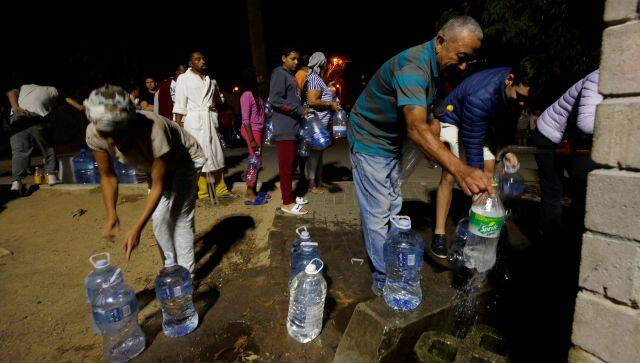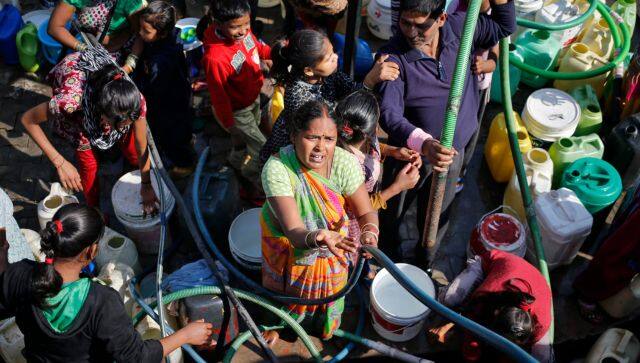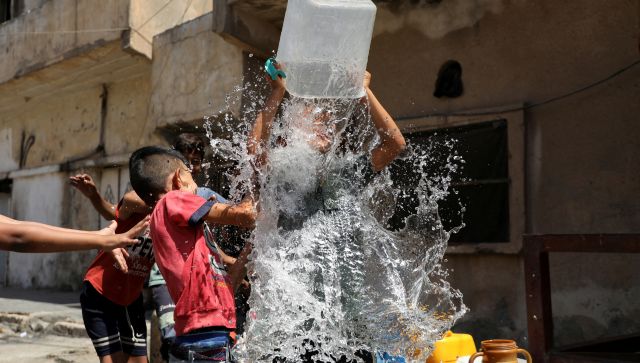India is among the 25 countries, which house a quarter of the global population, that face extremely high water stress each year, according to a report published by World Resources Institute’s (WRI) Aqueduct Water Risk Atlas on Wednesday (16 August). Bahrain, Cyprus, Kuwait, Lebanon and Oman are the top five worst-affected nations. ‘Extreme water stress’, as per the report, means that the country uses more than 80 per cent of its renewable water supply for irrigation, livestock, industry and domestic purposes. Water stress measures the demand for the resource in an area as compared to its available water supply. If the water stress is greater, the country is more prone to experience water shortages, particularly when demand is higher such as during a heatwave, noted Sky News. What are the other findings of the report? How worried should we be? What can be done? Let’s take a closer look. Global water demand to soar The report says that the worldwide demand for water has more than doubled since 1960.
This is likely to surge further by 20 to 25 per cent by 2050.
The highest increase in water demand – 163 per cent – is expected to occur in sub-Saharan Africa. “While most countries in Sub-Saharan Africa are not extremely water-stressed right now, demand is growing faster there than any other region in the world,” as per the WRI’s report. It attributes a rise in water demand to increasing populations and growing demands of industries such as agriculture, energy production and manufacturing. Moreover, the research says that unsustainable water use policies, a lack of investment in water infrastructure and climate change can also affect the available water supply. Most water-stressed regions Middle East and North Africa are the most water-stressed regions, with a whopping 83 per cent of the population exposed to extremely high water stress. In South Asia, 74 per cent of the population is vulnerable to such conditions. As per Charles Iceland, director of Freshwater Initiatives at the WRI, “If a country is using 100 per cent of its available supply, usually you’re going to start to see a few bad things happen,” reported Sky News. “Groundwater levels drop, rivers dry up, lakes dry up, wetlands dry up and we’re seeing that across places in the Middle East, like Iraq and Iran.” Water shortages can trigger industrial disruptions, power outages as well as losses in agricultural production, says the report. [caption id=“attachment_13009462” align=“alignnone” width=“640”] Increased water stress can harm the economic growth of countries. Reuters (Representational Image)[/caption] According to water risk research, heightened water stress can also harm the economic growth of countries. It also puts global food security at risk. About 60 per cent of global irrigated agriculture is facing extremely high water stress, especially sugarcane, wheat, rice and maize. “Yet to feed a projected 10 billion people by 2050, the world will need to produce 56 per cent more food calories than it did in 2010 — all while dealing with increasing water stress as well as climate-driven disasters like droughts and floods,” the report’s authors say. “Water is arguably our most important resource on the planet and yet we’re not managing it in a way that reflects that. I’ve been working in water for close to 10 years, and unfortunately, the story has been the same almost the entire 10 years,” Samantha Kuzma, Aqueduct data lead from WRI’s water program and a report author, told CNN. ALSO READ:
Drowning in Misery: How swimming pools of the rich are leading to a water crisis in the world
Water stress will worsen Currently, half the world’s population – four billion people – is exposed to extremely high water stress at least one month a year. This is set to worsen by 2050 when 60 per cent of the population could be subjected to such conditions. The researchers have sounded alarm that an additional one billion people are likely to witness extremely high water stress by that time even if the global warming threshold is limited to 1.3 to 2.4 degrees Celsius above pre-industrial levels. As per Aqueduct’s data, 31 per cent of global GDP – $70 trillion – will be exposed to high water stress by 2050, an uptick from 24 per cent in 2010. India, Mexico, Egypt and Turkey will account for over half of this exposed GDP in 2050. [caption id=“attachment_13009452” align=“alignnone” width=“640”]
Increased water stress can harm the economic growth of countries. Reuters (Representational Image)[/caption] According to water risk research, heightened water stress can also harm the economic growth of countries. It also puts global food security at risk. About 60 per cent of global irrigated agriculture is facing extremely high water stress, especially sugarcane, wheat, rice and maize. “Yet to feed a projected 10 billion people by 2050, the world will need to produce 56 per cent more food calories than it did in 2010 — all while dealing with increasing water stress as well as climate-driven disasters like droughts and floods,” the report’s authors say. “Water is arguably our most important resource on the planet and yet we’re not managing it in a way that reflects that. I’ve been working in water for close to 10 years, and unfortunately, the story has been the same almost the entire 10 years,” Samantha Kuzma, Aqueduct data lead from WRI’s water program and a report author, told CNN. ALSO READ:
Drowning in Misery: How swimming pools of the rich are leading to a water crisis in the world
Water stress will worsen Currently, half the world’s population – four billion people – is exposed to extremely high water stress at least one month a year. This is set to worsen by 2050 when 60 per cent of the population could be subjected to such conditions. The researchers have sounded alarm that an additional one billion people are likely to witness extremely high water stress by that time even if the global warming threshold is limited to 1.3 to 2.4 degrees Celsius above pre-industrial levels. As per Aqueduct’s data, 31 per cent of global GDP – $70 trillion – will be exposed to high water stress by 2050, an uptick from 24 per cent in 2010. India, Mexico, Egypt and Turkey will account for over half of this exposed GDP in 2050. [caption id=“attachment_13009452” align=“alignnone” width=“640”] India is among the 25 countries that face extremely high water stress each year. Reuters (Representational Image)[/caption] “Without better water management, population growth, economic development and climate change are poised to worsen water stress,” the WRI report warns. “People like to talk about
climate
change as the biggest existential threat to humanity, but water stress is climate change’s deadliest and most used weapon,” Crystal Davis, global director of WRI’s Food, Land and Water programme, was quoted as saying by The Messenger. What can be done? WRI report calls for better water management to reduce water stress. Citing the example of Singapore and the United States’ Las Vegas, it says that methods such as getting rid of water-thirsty grass, desalination, and wastewater treatment and reuse show how to manage scarce water resources. It notes that political will and financial backing are necessary to implement these “cost-effective” solutions. With climate change, “water challenges are only going to become more frequent and more intense,” Heather Cooley, director of research for the Pacific Institute, told The Washington Post. “That needs to motivate us to begin preparing and implementing projects.” With inputs from agencies
India is among the 25 countries that face extremely high water stress each year. Reuters (Representational Image)[/caption] “Without better water management, population growth, economic development and climate change are poised to worsen water stress,” the WRI report warns. “People like to talk about
climate
change as the biggest existential threat to humanity, but water stress is climate change’s deadliest and most used weapon,” Crystal Davis, global director of WRI’s Food, Land and Water programme, was quoted as saying by The Messenger. What can be done? WRI report calls for better water management to reduce water stress. Citing the example of Singapore and the United States’ Las Vegas, it says that methods such as getting rid of water-thirsty grass, desalination, and wastewater treatment and reuse show how to manage scarce water resources. It notes that political will and financial backing are necessary to implement these “cost-effective” solutions. With climate change, “water challenges are only going to become more frequent and more intense,” Heather Cooley, director of research for the Pacific Institute, told The Washington Post. “That needs to motivate us to begin preparing and implementing projects.” With inputs from agencies
)